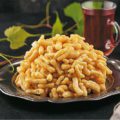If you’re ever invited to a Russian home, you’ll most likely be treated to hot tea and sweets. Russians have an enormous sweet tooth, and Russian cuisine has built up quite a repertoire of delicious sweets over the centuries.
Recipes for national desserts have been carefully passed down from generation to generation, and many of them have survived to this day almost unchanged. There is a great variety of unusual traditional Russian sweets, even though most of them are made from the simplest ingredients that can be found in any kitchen.
Russian Cuisine
Russian jam called Varenye is a traditional dessert of Russian cuisine. It is made by boiling fruits or berries with sugar for preserving purposes. Unlike confiture and American jam, Russian jam is prepared so that the ingredients retain their shape. It has a heterogeneous consistency and consists of a more or less liquid syrup and individual pieces of cut fruits and whole berries. Other ingredients for Varenye might surprise you, for example, zucchini, young walnuts, rose petals, and even pine cones!
Varenye is served in small bowls as a separate treat or as a topping for pastries and desserts, such as ice cream or pancakes.
Due to the peculiarities of the climate, in Russian cuisine, there are many desserts made with apples. Apples easily tolerate temperature changes and can be stored for a long time. Despite the fact that most of the varieties that grow in Russia are somewhat sour, over the centuries Russian cooks have found ways to make tasty desserts from them. Apples were soaked in syrups and sweet decoctions, cored and filled with various fillings. An apple baked with nuts, honey, or other filling is a healthy food rich in potassium and iron. Nutritionists say that regular consumption of baked apples not only helps to lose extra pounds, but also enhances metabolism, improves skin condition and even smoothes out fine wrinkles.
Sour apples are the basis of another popular Russian sweet — pastila. Initially, the sweet was made from egg white, honey and applesauce. It was distinguished by a rich aroma and taste. Pastila was sold at fairs usually in the form of rolls or pies. There were also variations of the dessert. For example, it could be prepared with cranberries, currants, raspberries, mountain ash or lingonberries.
Kolomna and Belev are considered the cradle of pastila. There it was prepared using a carefully protected recipe and was called levash. There it is dried in the sun and baked in a Russian masonry stove to this day.
Over time, replacing honey with sugar, Russian confectioners began to make white and thick pastila — the forerunner of Zephir, which is still very popular.
Of course, the story about Russian national sweets would not be complete without mentioning the Vatrushka. The recipe for round buns with a filling in the middle has come down to us from time immemorial and has not changed ever since.
Vatrushka dough can be different — unleavened, shortbread, rich or flaky, but in the classic version, only yeast bread dough was used. The filling is also very simple — baked quark (a sort of curd) mixed with sugar, jam or fruit puree. The cold variation of the pastry is usually served with fruit drink, and the warm one — with tea.
Sweets of the Volga Region
There is the recipe for making Chak-chak. Unlike pastila, Chak-chak has not changed since long time ago. This oriental delicacy is considered the national dish of the Tatars and Bashkirs and originates in Turkey. Dessert is made from soft dough and raw eggs, cast into short thin sticks resembling noodles. They are deep-fried, piled up on a dish and drenched with a hot honey syrup. Before serving, the honey heap is left to harden until completely solidified.
The national Tatar cuisine is famous for another dessert, albeit less popular than Chak-chak. It is Talkysh-kaleve that resembles small pyramids with a sweet aroma and creamy honey taste. Cones that melt in the mouth made of sugar threads date back to the end of the 19th century. The dish reminds of Turkish sweets, which can be easily explained. Borhan-baabay, the author of the original Talkysh-kaleve recipe, brought it to the Kazan province from Turkish captivity. Basing on several oriental recipes, he came up with his own dessert. The composition of the sweet seems very simple, but women assure that it is very much appreciated, because not everyone can cook it really tasty. Today Talkysh-kaleve is one of the most difficult food to make out of all Tatar cuisine, which is made exclusively in Tatarstan. The benefits of this dessert lie in the rapid replenishment of the body’s energy needs. The flow of glucose into the blood causes a temporary improvement in mood and stimulates the brain.
Caucasus Desserts
An equally beneficial and healthy dessert is rooted in the culture of the Caucasus. Churchkhela is prepared by stringing various nuts and then dipping the string in flour-thickened sweet grape juice.
This dessert takes the longest time to make. Each Churchkhela must dry in the sun for at least two weeks, and then it is left to mature for up to three months. The dessert contains a huge amount of glucose and fructose, vegetable oils, proteins, organic acids and vitamins.
The originality and unique taste of national sweets of Russia have more than once amazed foreign tourists because they are so different.
Despite the unique variety of traditional Russian sweets, most of these desserts are made from simple and accessible ingredients.
Elena Malinovskaya





